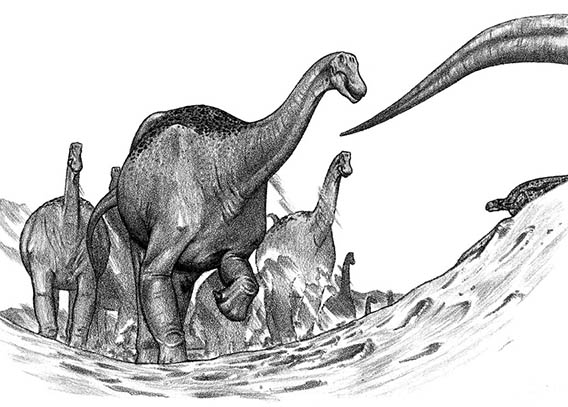
|
Search JoyZine with Google Site Search! |
Austrosaurus 
The fossil was dubbed "Elliot" after a family member of the owners of the sheep station. With the femur estimated at between 1.5 and 1.7 metres in length, it may turn out to be the largest dinosaur yet discovered in Australia. Estimates suggest it may have been 16 to 21 metres in length—longer than the known Austrosaurus specimens, and potentially bigger than Australia's current record holder, Rhoetosaurus at about 18 metres. This Austrosaurus was a large (15m), long-necked plant-eater. It had elongated bones below its wrist, and long forearms. The tail bones were relatively simple. Austrosaurus (Southern Reptile) was initially classified as Cetiosaurinae. However the vertebrae of Austrosaurus are much more solid and primitive than those known for Cetiosaurus, or for any other sauropod dating to the Cretaceous. It is the primitive vertebrae that distinguish this as a separate species to the only other well known Australian sauropod, Rhoetosaurus brownei from the Middle Jurassic. Ironically the vertebrae of Rhoetosaurus, one of the earliest known species of sauropod, are much more "advanced" than those of the younger Austrosaurus, with hollows and buttresses within them that help make them lighter while not sacrificing strength. Elliot's remains were found in a layer of sediments known as the Winton Formation, which dates to between 97 and 95 million years ago. This is the same formation where the fragmentary remains of five Austrosaurus sp were found in 1959, near the town of Maxwelton. The original specimen of Austrosaurus, A. mckillopi, is from the Allaru Mudstone Formation that dates to around 98-99 MYA, making it slightly older than Elliot or the other five individuals known. Elliot's vertebrae are similar to those known for Austrosaurus sp, but there are slight differences in the shape of the femur. This new sauropod may be a third species of Austrosaurus, or a closely related animal. It is currently thought that Austrosaurus may be related to the titanosaurs, however these sauropods may turn out to be a uniquely Australian group not closely related to sauropods from other parts of the world. Elliot lived alongside several other types of dinosaurs. These included large, Allosaurus-sized theropods, small, two-legged carnivores called coelurosaurs, and plant-eating ornithopods, some of which were probably similar to Austrosaurus, has since been shown to be related to the Titanosaurs, a group of (mostly) Southern Hemisphere sauropods characterised by (among other things) armoured scutes embedded within the skin. Muttaburrasaurus, Australia’s best-known dinosaur. Footprints of all these dinosaurs are preserved in stone at Lark Quarry Conservation Park, along with the world's only known record of a dinosaur stampede. It has been known for more than a decade that Australia was home to sauropods as large as Elliot, but until recently there have been no bones to prove it. Between 1987 and 1993, enormous sauropod footprints were discovered on the wave-washed rock platforms around Broome, Western Australia. Most of the Broome sauropod footprints are 45cm—90cm wide, but at least one set of tracks belongs to an animal with feet an incredible 1.5m wide— wider than the tyres on most semi-trailers. Footprints this size can only have been produced by a truly gigantic animal, whose size may have surpassed even that of the mighty Argentinosaurus and Paralititan. |